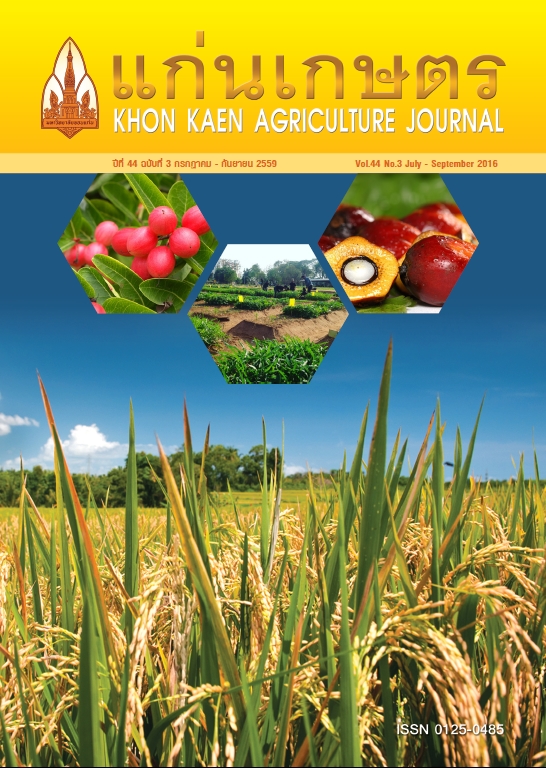Responses of rainfed lowland rice genotypes to terminal drought in Northeast Thailand
Main Article Content
บทคัดย่อ
In Northeast Thailand, rainfed lowland rice often experiences terminal drought that develops around flowering and become severe during the flowering-grain filling stage. Two drought (drought trial 1 and 2) and well irrigated control trials were conducted with 35 genotypes of rainfed lowland rice to determine the traits that contribute to high yield under water - limitinged conditions, particularly the importance of roots system development under terminal drought conditions. In drought trial 2 a gravel layer was added at 10-20cm below the soil surface to discriminategenotypes for deep rooting, while in drought trial 1 there was no gravel layer.Genotypic consistency in root mass and number between the two trials was examined and implication of well-developed root system on growth determined. Because of the long duration of the terminal drought grain yield was more severely affected in later flowering genotypes particularly in drought trial 1. On the other hand, in drought trial 2 with the gravel layer, some late flowering genotypes which had more extensive root systems, i.e. larger root mass and root number were able to produce higher yield than others and they generally had shorter delay in flowering. Correlation analysis suggested that genotypes with more extensive root system were able to maintain higher leaf water potential which resulted in maintaining larger panicle density. In drought trial 2, genotypes that maintained higher leaf water potential produced higher grain yield. It is thus suggested that adaptation of rainfed lowland rice to terminal drought conditions can provide drought escape in general, but also more specifically, certain types of rainfed lowland and certain methods of cultivation (such as adding a gravel layer) can provide an avoidance mechanism through extensive root system development to maintain better plant water status, and therefore survive terminal drought. Under the drought trial 2 where grain yield level was higher than trial 1, delay in flowering is shown to be a trait that could be used as a selection criterion.
Article Details
เอกสารอ้างอิง
Bocco, R., M. Lorieux, P.A. Seck, K. Futakuchi, B. Manneh, H. Baimey, and M.N. Ndjiondjop. 2012. Agro-morphological characterization of a population of introgression lines derived from crosses between IR 64 (Oryza sativaindica) and TOG 5681 (Oryza glaberrima) for drought tolerance.Plant Sci. 183: 65-76.
Chu, G., T.T. Chen, Z.Q. Wang, J.C. Yang, and J.H. Zhang. 2014. Morphological and physiological traits of roots and their relationships with water productivity in water-saving and drought-resistant rice.Field Crops Res. 162: 108-119.
Ekanayake, I.J., J.C. O’Toole, D.P. Garrity, and T.M. Masajo. 1985. Inheritance of root characters and their relations to drought resistance in rice.Crop Sci. 25: 927-933.
Fukai, S. 1999. Phenology in rainfed lowland rice.Field Crops Res. 64: 51-60.
Fukai, S., and M. Cooper. 1995. Development of drought-resistant cultivars using physiomorphological traits in rice.Field Crops Res. 40: 67-86.
Fukai, S., and M. Cooper. 1999. Plant breeding strategies for rainfed lowland rice in Northeast Thailand. p. 153-156. In: Proceedings of International Symposium Kyoto, Japan, 8-9 October 1999. Henry, A., V.R.P. Gowda, R.O. Torres, K.L. McNally, and R. Serraj. 2011. Variation in root system architecture and drought response in rice (Oryza sativa): Phenotyping of the Oryza SNP panel in rainfed lowland fields. Field Crops Res. 120: 205-214.
Jearakongman, S., S. Rajatasereekul, K. Naklang, P. Romyen, S. Fukai, E. Skulkhu, B. Jumpaket, and K. Nathabutr. 1995. Growth and grain yield of contrasting rice cultivars grown under different conditions of water availability.Field Crops Res. 44: 139-150.
Jongdee, B., S. Fukai, and M. Cooper. 2002. Leaf water potential and osmotic adjustment as physiological traits to improve drought tolerance in rice.Field Crops Res. 76: 153-163.
Kamoshita, A., R.C. Babu, N.M. Boopathi, and S. Fukai. 2008. Phenotypic and genotypic analysis of drought-resistance traits for development of rice cultivars adapted to rainfed environments.Field Crops Res. 109: 1-23.
Kato, Y., A. Kamoshita, and J. Yamagishi. 2007. Evaluating the resistance of six rice cultivars to drought: restriction of deep rooting and the use of raised beds.Plant and Soil. 300: 149-161.
Kijoji, A.A., S. Nchimbi-Msolla, Z.L. Kanyeka, R. Serraj, and A. Henry. 2014. Linking root traits and grain yield for rainfed rice in sub-Saharan Africa: Response of Oryza sativa x Oryza glaberrima introgression lines under drought.Field Crops Res. 165: 25-35.
Kumar, R., A.K. Sarawgi, C. Ramos, S.T. Amarante, A.M. Ismail, and L.J. Wade. 2006. Partitioning of dry matter during drought stress in rainfed lowland rice.Field Crops Res. 98: 1-11.
Monkham, T., B. Jongdee, G. Pantuwan, J. Sanitchon, J.H. Mitchell, and S. Fukai. 2015. Genotypic variation in grain yield and flowering pattern in terminal and intermittent drought screening methods in rainfed lowland rice.Field Crops Res. 175: 26-36.
Ouk, M., J. Basnayake, M. Tsubo, S. Fukai, K.S. Fischer, M. Cooper, and H. Nesbitt. 2006. Use of drought response index for identification of drought tolerant genotypes in rainfed lowland rice. Field Crops Res. 99: 48-58.
Ouk, M., J. Basnayake, M. Tsubo, S. Fukai, K.S. Fischer, S. Kang, S. Men, V. Thun, and M. Cooper. 2007. Genotype-by-environment Interactions for grain yield associated with water availability at flowering in rainfed lowland rice.Field Crops Res. 101: 145-154.
Pantuwan, G., S. Fukai, M. Cooper, J.C. O’Toole, and S. Sarkarung. 1997. Root traits to increase drought resistance in rainfed lowland rice. p. 170-179. In: Fukai, S., Cooper, M. Salisbury, J. (Eds.), Proceedings of an International Workshop, Ubon Ratchathani, Thailand, 1996. Australian Centre for International Agricultural Research, Canberra, ACT.
Pantuwan, G., S. Fukai, M. Cooper, S. Rajatasereekul, and J.C. O’Toole. 2002. Yield response of rice (Oryza sativa L.) genotypes to different types of drought under rainfed lowlands - Part 1. Grain yield and yield components.Field Crops Res. 73: 153-168.
Sibounheuang, V., J. Basnayake, and S. Fukai. 2006. Genotypic consistency in the expression of leaf water potential in rice (Oryza sativa L.).Field Crops Res. 97: 142-154.


